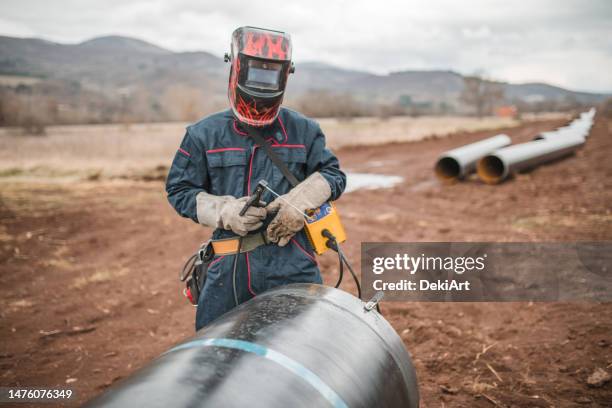Advanced Techniques in Pipe Welding Assessment: Advancements and Technologies for Boosted Precision and Dependability in Weld Analysis
The landscape of pipe welding examination is undergoing a considerable change, driven by sophisticated methods that promise to enhance both precision and dependability in weld analyses. Advancements such as automatic assessment systems and progressed imaging modern technologies are redefining traditional practices, while non-destructive screening approaches make certain product honesty is maintained. As these modern technologies advance, they not only boost issue detection prices however also allow extra effective upkeep approaches. However, the implications of these innovations expand past prompt advantages, increasing vital inquiries regarding future methods and requirements in the industry.

Importance of Weld Examination
Making sure the honesty of pipe welds is important to the total safety and integrity of commercial systems. Extensive evaluation of welds is essential to the lifecycle of pipeline infrastructure.
The value of weld assessment expands beyond plain compliance with regulatory standards. It works as a positive action to determine and fix flaws, such as insufficient combination, porosity, or cracks, prior to they escalate right into major issues. Reliable examination techniques also add to the durability of pipelines, decreasing maintenance expenses and enhancing functional efficiency.
Moreover, comprehensive weld examinations foster trust fund amongst stakeholders, including governing bodies, investors, and the communities offered by these pipelines. By making sure that all welds meet the needed criteria, organizations can alleviate risks and maintain their reputations. In summary, weld examination is important not just for functional integrity but additionally for the broader ramifications it holds for safety and security and environmental stewardship.
Automated Assessment Systems
The integration of automatic inspection systems in pipe welding has actually revolutionized the method to making sure weld top quality and integrity. These systems employ sophisticated robotics and man-made knowledge to carry out examinations that are not only quicker yet additionally extra consistent than conventional techniques. Automated systems can cover substantial sizes of pipes effectively, catching data that human examiners might overlook due to tiredness or environmental conditions.
One of the essential advantages of automatic examination systems is their capability to operate in dangerous environments, reducing the risk to human inspectors. They make use of numerous non-destructive screening (NDT) methods, such as ultrasonic testing and magnetic fragment evaluation, to evaluate weld stability without compromising the structure. The data collected is refined in real-time, enabling prompt responses and timely restorative activities when problems are identified.
Furthermore, automated systems help with the standardization of examination procedures, guaranteeing that each weld is evaluated against consistent standards. This not only enhances the integrity of outcomes but additionally enhances compliance with regulatory criteria. As markets continue to focus on safety and functional performance, the function of automated assessment systems in pipeline welding will unquestionably expand, leading the way for a lot more advanced quality control methodologies.
Advanced Imaging Technologies
Regularly utilized in modern-day pipe welding evaluations, progressed imaging innovations have dramatically improved the capacity to spot and analyze weld issues. Techniques such as electronic radiography, calculated tomography, and thermographic imaging give examiners with high-resolution images that expose sub-surface defects and architectural disparities that may be undetectable to the nude eye.
Digital radiography utilizes electronic sensing units to capture photos, enabling for prompt evaluation and boosted picture comparison. This brings about faster examinations and enhanced accuracy in determining critical problems. Calculated tomography, on the various other hand, uses three-dimensional imaging, making it possible for examiners to envision complicated geometries and analyze the stability of welds from several angles - Pipeline Welding Inspection. This depth of evaluation is very useful for spotting issues that conventional techniques might ignore.
Thermographic imaging employs infrared innovation to discover variations in temperature level, determining locations of prospective weak point or anxiety within the weld. These innovative imaging modern technologies not only enhance problem discovery rates but additionally lower the moment and sources needed for pipe assessments. Consequently, they play a critical duty in keeping pipe security and dependability, guaranteeing compliance with industry criteria while decreasing functional threats.
Non-Destructive Examining Approaches
Making use of different techniques, non-destructive testing (NDT) techniques are necessary in pipeline welding evaluations, enabling the evaluation of weld honesty without compromising the product's architectural integrity. NDT includes a variety of techniques, including ultrasonic screening (UT), radiographic testing (RT), magnetic fragment screening (MT), and dye penetrant testing (PT) Each method has unique benefits and applications depending on the details demands of the evaluation.
Ultrasonic screening utilizes high-frequency audio waves to spot inner defects, supplying precise measurements of weld thickness and honesty. Pipeline Welding Inspection. Radiographic screening employs X-rays or gamma rays to create images of the weld, disclosing internal issues that might not be visible externally. Magnetic fragment testing works for detecting surface and near-surface gaps in ferromagnetic products, while dye penetrant testing highlights surface area fractures by utilizing a colored color
Integrating these NDT approaches into pipe welding evaluations boosts the accuracy and integrity of weld evaluations, ensuring that possible failings are identified early. As see here now markets require greater criteria for safety and security and performance, the duty of NDT in maintaining the stability of bonded frameworks remains to be essential in pipe building and upkeep.

Future Patterns in Weld Evaluation
As we look to the future of weld assessment, advancements in technology are poised to transform the methods utilized for assessing pipe stability. The assimilation of synthetic knowledge (AI) and maker understanding in assessment processes is anticipated to improve the precision of imperfection discovery and anticipating upkeep. These modern technologies enable for real-time data evaluation, allowing examiners this to identify possible problems prior to they rise into substantial troubles.
In addition, making use of drones equipped with advanced imaging systems is gaining grip. These aerial inspections can cover huge areas rapidly, recording high-resolution images and information that can be evaluated for issues in hard-to-reach places. This not just boosts safety and security however also enhances performance in the evaluation procedure.
In addition, the advancement of wise sensors embedded in pipeline systems uses the possibility for continuous tracking. These sensors can spot adjustments in pressure, temperature, and resonances, offering useful insights into the wellness of the welds with time.

Final Thought
Finally, the combination of sophisticated methods in pipe welding assessment considerably boosts the precision and integrity of weld evaluations. Advancements such as computerized inspection systems, advanced imaging technologies, and non-destructive testing techniques play a crucial duty in enhancing flaw detection rates and cultivating positive maintenance strategies. As these modern technologies proceed to develop, they will further make certain the security and efficiency of pipe systems, eventually adding to the integrity of essential infrastructure.
